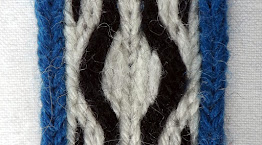There are a variety of things that can go wrong with a band, and most of them have happened to me over the years. In this tutorial, I hope to help you to diagnose the problems that can be caused by turning errors and solve them in your own weaving.
We'll be using the following band and draft (made using Tablet Weaving Draft Designer) in some of the examples:
Figure 1: The band as it will look if woven based on the draft below, without any errors
Figure 2: The draft used to weave the example band
Figure 3: Little black pips appear in the centre of the lozenge shape here due to a turning error
Figure 4: This draft of the band above shows that the pips are caused by there being the wrong number of forward turns
In the example band, the pattern tablets are turned forwards for three rows (also called picks), then backwards for three rows. Here (figure 3), the tablets have been turned forwards for four picks, then backwards for four picks.
Figure 5: The middle of the pattern repeat in this part of the band appears elongated, if you lift the long threads (right) you can see other warp threads passing under and over the weft
Figure 6: The draft shows that the long threads in the middle are caused by turning the tablets backwards, then forwards, then backwards
Figure 7: I wove this band as a Brewer's Guild competition prize about 9 years ago. It uses this type of turning to turn an hourglass shape into a goblet (the pattern is from John Mullarkey's Tablet Weaver's Pattern Book)
This next turning error is caused by turning the tablets forwards for three picks, then backwards for one pick, then forwards for one pick, then finally backwards for three picks. This causes the pattern to look elongated at the point where the three turning direction changes happen. If you lift up the long warp threads on the surface of the band, you will see the threads inside travelling over and under the weft. This problem is usually caused by losing your place in the pattern, but can be included intentionally for effect.
Figure 8: Here the elongated threads are caused by some threads idling, if you lift up the long threads (right) you can see that the weft isn't covered by any warp threads, so the tablets haven't been turned
This error looks similar to the one above, but this time is caused by idling tablets, as in some tablets have not been turned, while others have. This time if you lift up the long warp threads, you will see that none of the warps on the inside are interacting with the weft. Intentionally idling tablets are used by Shelagh Lewins in her interpretation of the Cambridge Diamonds band. I haven't included a draft for this one, as it's not something that TDD can do.
Figure 9: Note the horizontal line in the middle of the picture, where the threads appear to sit on top of one another
If the tablets are turned twice (for a half turn rather than the usual quarter turn), it will cause places in the band where two threads are visible, rather than one. That part of the pattern will advance faster than the rest, which can cause tablets to become out of step from each other. This can be useful if you need part of the pattern to line up with the rest when it wouldn't normally do so. The technique is demonstrated in the book Applesies and Foxnoses - Finnish Tabletwoven Bands. Again, this isn't something that TDD is able to do, so I haven't included a draft.











No comments:
Post a Comment